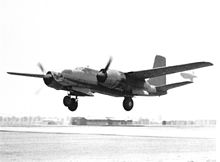Douglas A-26 Invader
Designed by Ed Heinemann, Robert Donovan, and Ted R. Smith,[4] the innovative NACA 65-215 laminar-flow airfoil wing of the A-26 was the work of project aerodynamics expert A.M.O.Flight tests revealed excellent performance and handling but engine-cooling problems led to cowling changes and elimination of the propeller spinners on production aircraft.In most missions, a third crew member in the rear gunner's compartment operated the remote-controlled dorsal and ventral gun turrets, with access to-and-from the cockpit via the bomb bay only if that was empty.As he pressed the handles downward, and as the bead passed the centerline, the mirror automatically flipped, transferring the sight "seamlessly" to the lower periscope.While novel and sound in principle, the developers invested a great deal of time and effort in their attempts to get the system to work, delaying production.[13] Aircrew from "The Grim Reapers", while evaluating these four A-26Bs, noted that downward views from the cockpit were significantly hindered by the nature of the design – especially the positioning of the engines – which made the A-26B unsuitable for its intended role of ground attack.[15] Douglas needed better results from the Invader's second combat test, so ferried A-26s arrived in Europe in late September 1944 for assignment to the Ninth Air Force.In contrast to the Pacific-based units, the A-26 was well received by pilots and crew alike, and by 1945, the 9th AF had 11,567 missions, dropping 18,054 tons of bombs, recording seven confirmed kills while losing 67 aircraft.They were used against German transport links, and for direct support and interdiction against tanks and troop concentrations in the Po Valley in the final campaigns in Italy.In June 1951, they joined the 3rd Bomb Wing (Kunsan (K-8)) in night activity only, dividing the target areas, with the 452nd taking the eastern half and the 3rd the western.[25] The aircraft from Laos participated in the early phase of the Vietnam War with the USAF, but with Vietnamese markings as part of Project Farm Gate.[30] In response to this, the On Mark Engineering Company of Van Nuys, California, was selected by the USAF to extensively upgrade the Invader for its new counterinsurgency role.On Mark converted 40 Invaders to the new B-26K Counter-Invader standard of upgraded engines, propellers, and brakes, remanufactured wings, and wing-tip fuel tanks for use by the 609th Special Operations Squadron.[32][33][34] The CIA contracted pilots, some employed during the Bay of Pigs Invasion, to fly B-26Ks for ground attack against Simba rebels in the Congo Crisis.Concerned about Indonesian President Sukarno's communist leanings, the CIA started Operation Haik in 1958 to overthrow his Guided Democracy in Indonesia regime.[38] The capture and trial of Lieutenant Pope brought a quick end to Operation Haik, but the capabilities of the Invader were not lost on the Indonesian government.[48] The initial main civil uses were as "executive" personnel transports with minimal modifications such as removal of military features, bomb-bay doors sealed shut, passenger-entry stairs in bomb bay, and the conversion of the fuselage to accept six to eight passengers.[49] During the mid-1950s, A-26s were tested and used as air tankers for suppression of forest and wildland fires, and briefly used borate-based retardants, hence the inaccurate and unofficial term "borate bombers".Borate was later discontinued due to its undesirable ecologic effects, replaced with retardant mixtures of water, clays, fertilizers, and red dyes.[10] Much early development of conversions was carried out by Grand Central Aircraft, whose drawings and personnel were taken up by the On Mark Engineering Company of Van Nuys, California, from about 1955.[54][55]General characteristics Performance Armament In July 2005, the archaeological television program Time Team of the UK's Channel 4, along with members of RAF Millom Museum, took part in a major project to excavate the crash sites of two A-26 Invader aircraft after the aircraft collided shortly after take-off over marshes close to the then USAAF BAD 2 airbase at Warton in Lancashire on 29 November 1944.



















Martin B-26 MarauderwarbirdGround attackLight bomberManufacturerDouglas Aircraft CompanyUnited States Army Air ForcesUnited States Air ForceUnited States NavyFrench Air ForceColombian Air ForceOn Mark Executive, Marketeer, and MarksmanWorld War IICold WarSoutheast AsiaEd HeinemannTed R. SmithA.M.O. SmithprototypeMines FieldEl SegundoBenny Howardcowlingpropeller.50 caliber machine gunsNorden bombsightcanopynavigatorbombardierLancasterBlenheimBeaufortWellingtonFifth Air ForceSouthwest Pacific theater3rd Bombardment GroupJapaneseManokwariGeorge KenneyFar East Air ForcesDouglas A-20 HavocsNinth Air Force416th Bombardment Group409th Bombardment GroupTwelfth Air Force47th Bomb GroupStrategic Air CommandU.S. Air Forces in EuropeTactical Air CommandAir National GuardU.S. NavyC-130 HerculesNational Guard BureauNational Air and Space MuseumKorean WarPyongyangAir Force Reserve452d Bombardment WingMiho Air BasePusan East (K-9) Air BaseKunsan (K-8)17th Bomb WingJohn S. Walmsley Jr.Medal of Honorarmistice agreementTakhli RTAFBThailandCentral Intelligence AgencyOperation MillpondRoyal Lao GovernmentPathet LaoBay of Pigs invasionFarm GateVietnam WarClark ABT-28 TrojanDouglas A-1 SkyraiderEglin AFB1st Air Commando WingHurlburt Field609th SOSOn Mark EngineeringVan Nuys, CaliforniacounterinsurgencyVan Nuys Airport609th Special Operations Squadronattack aircraftHo Chi Minh trailCuban Air ForceDuke FieldCuban exileAlabama Air National GuardCongo CrisisBombardment Group I/19 GascogneFirst Indochina WarCat BiDien Bien Phusiege of Dien Bien PhuPhilippinesViet MinhJoint Chiefs of StaffOperation VultureSukarnoGuided Democracy in Indonesiacovert operationAllen PopeNorth American P-51 MustangIndonesian Air ForceDavis-Monthan AFBIndonesian invasion of East TimorPortuguese Air ForcePortuguese AngolaPortuguese Colonial WarDragon operationsBiafraNigerian Civil WarJan ZumbachTulsa, OklahomaLong Beach, CaliforniaAN/APQ-13HVAR rocketsV-J DayR-2800General Electric J31Pratt & Whitneyhardpoint